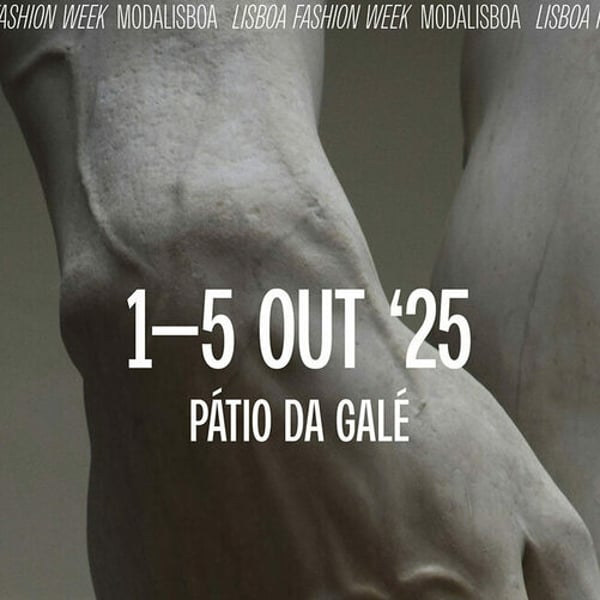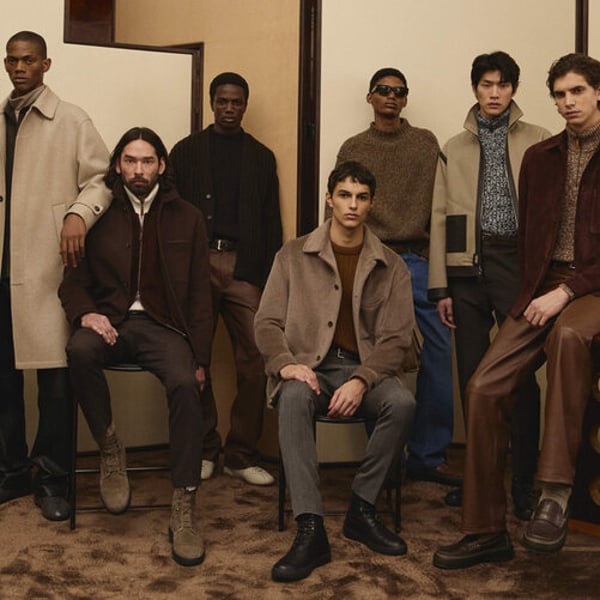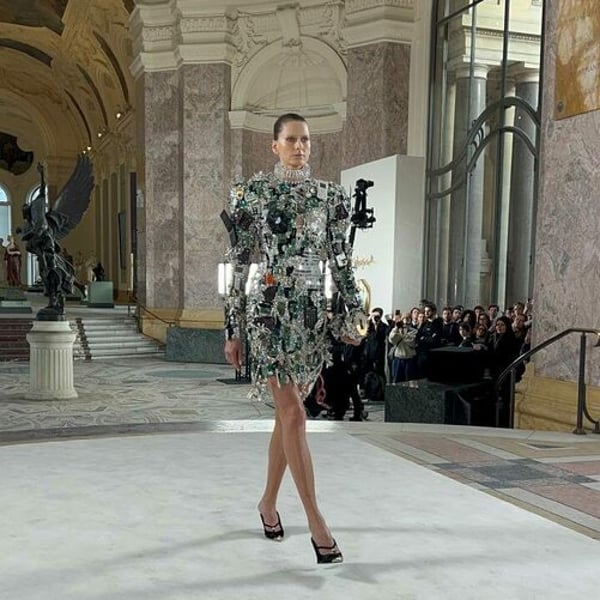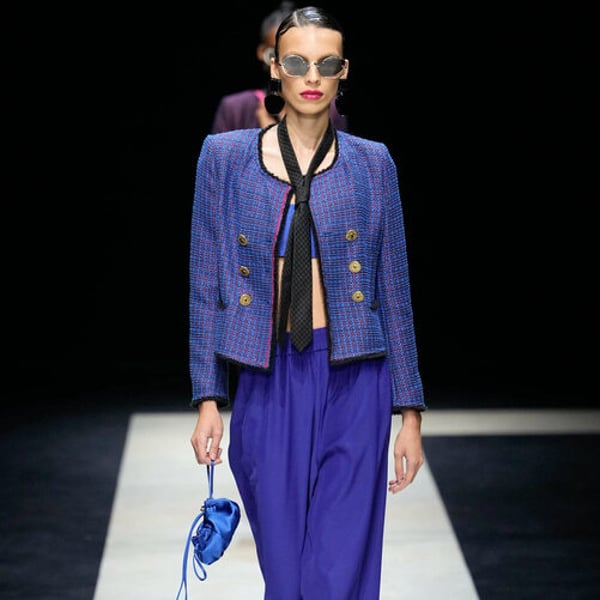Translated by
Nazia Bibi Keenoo
Published
September 1, 2025
It does not have to be a great corporation to be relevant in the fashion industry. That is the mantra that seems to guide Oslo's track since his birth a decade ago. The catwalk, with the Norwegian capital and its rich inheritance, culture and nature as a backdrop, celebrated its first 10 years of existence from August 25 to 30. During these days, and through a comprehensive and carefully planned program, the city exhibited the talent and creativity of its brands, both established and emerging, using a one a hybrid format that combined fashion parades, presentations, emerging windows and talks.
“The Oslo track began 10 years ago with a bold vision: show Norwegian fashion at the professional level and do something we would be proud of internationally. And that is quite bold,” said Elin O. Carlsen, CEO of Oslo Runway, at the opening ceremony. “Now that we have traveled to different fashion cities, we see that people want to come, join our culture and see our designers. This platform promotes creativity, crafts and collaboration.”
He also pointed out the creative ecosystem that now surrounds the event, with stylists, photographers, consultants and creators who reinforce the industry.
“In terms of growth, numbers speak for themselves. From 2015 to date, the total turnover of our main fashion and lifestyle brands has increased by 1,100%. This demonstrates the vision, resistance and business impulse behind this industry,” added Elin Kathrine Saunes, president and CEO of Norwegian Fashion Ambub. “The recent government export initiative confirms that Norwegian fashion is a stock -generating industry.”
Oslo has fashion, nature and culture heritage
Under a bright sun that seemed to conspire with the organization to seduce national and international attendees, in its tenth edition, the track show invited the international press, buyers and distributors of the key markets for Norwegian fashion, such as Japan, Oslo Runway began its anniversary on Monday, August 25, with a ceremony to open an open beer an open -explorer ship and in collaboration with collaboration with collaboration with the Shaper Jewelry Jewelry Jewelry, Jewelhine Josephine's signature. Navigating through the Oslo Fjord, the track made a statement of intention: “This is what we are, and this is what we can offer to the fashion world.”

The second outstanding point of the first day was a fashion parade on Monday afternoon at the Munch Museum in Oslo. The imposing building, opened in 2021 and designed by the Spanish architect Juan Herreros, began the construction in 2015. It houses more than 26,000 works by the Norwegian expressionist painter Edvard Munch, author of “The Scream” and “The Sun”.
The latter was precisely the inspiration for the “Solen” collection of Pearl Octopuss, which includes jewels, accessories, bags and declaration garments such as Blazers. “The Sun”, and the rightly called Monumental Room that houses him, served as a backdrop for the spring-summer debut of the 2026 collection, accompanied by live electronic music played by Gundlach.
The hoops, the large pearls, the pieces of orange tones and the accents that echoed a sunset, including marginal details in bags, buttons and belts, created a fusion of images and sound, resonating with the huge works of art in the room and the musical environment.
Later that night, Pearl Octopuss. And he received the Runra Oslo tribute award at the catwalk anniversary. This award recognizes exceptional contributions to Norwegian fashion and has previously gone to Livid (2021), Tom Wood (2022), over1973 (2023) and Norwegian Rain (2024).
Nordic minimalism long life
If the first day of the Oslo track focused on Norway's impressive nature and the legacy of one of its most famous artists, the second day brought a more intimate mood.

The over1976 showed its designs in a marked minimalist space, where the feces were practically the only decoration, apart from the morning of the sun illuminating the clean tailoring. The acute sharp silhouettes of the brand spoke for themselves.
“We are minimalists with a distinctive touch. With this collection, our goal was to return to our roots and relive some of our exclusive pieces. The tailoring is essential for our brand, and we add new colors to the designs that have been with us for several seasons,” said Celine Aagaard, co -founder of Avelope1976 with Pia Nordskaug.
Satén, leather and scissors appeared largely in the alignment, along with reversible designs and layers in layers. “For all the costumes, we use Italian wool. We produce in Istanbul with the same supplier with which we have worked from the beginning. Some fabrics are made there, while others are made in Italy. The sheep comes from China, the leather of India and our swimsuits, although they are not shown today, in Portugal,” Aagaard said.
At its headquarters, with the buzzing of sewing machines establishing the tone, ESP presented its fifteenth collection, combining spring-summer 2026 garments made of Deadstock with a recycled wool capsule locally.

“Through the Noriego 'Innovative project of NF & TA, and in collaboration with Norsk Tekstilgjenvinning, Selbu Spinneri and Gudbrandsdalen Uldvarefabrikk, especially developed the first Norwegian recycling innovative with a local value chain. The result was a gender selection of jackets, coats and exter Marine, gray and brown, designed with football boots, including tacos.
In the internal patio of their offices, surrounded by red brick buildings with an industrial past, Camila Pihl debuted its spring collection. The suede jackets, the basic food foods and cotton shirts anchored alignment. Founded in 2018 by its homonym entrepreneur, the brand now operates four stores in Oslo, Bergen and Trondheim, and is sold in 125 points of sale of multiple brands, 25 of which are abroad. He hopes to overcome Nok 100 million (€ 8.5 million) in sales by 2025.
Christian Aks, guided by the concept of “sculpted simplicity for the modern closet”, presented “tide”, inspired by the stillness and strength of the sea. Soft and structured pieces in silk organza, cotton and sheep skin with texture captured that duality.

In a more urban key, the F5 collections (also with a live musical performance) added a more urban sensation, showing printed pieces, including Vichy and Klein Blue, which broke the prevailing minimalist aesthetics. A live musical presentation completed the show.
Cohmé Atelier and Wilhelmina, selected for the Oslo Runway Next program, led to the catwalk with bright designs. Cohmé hugged the glamor cabaret of the 1930s with vintage sequins and silhouettes. Pia Tjelta closed the night with a performance at the NationalTheatret, revealing a collection of romantic satin dresses, embroidered lace dresses and velvet stripes, all placed against the greatness of the roof paintings.
From basic timeless concepts to knitted clothes as national pride
On the third day, the official fashion parades wrapped with a celebration of refined basic costume products. Julie Josephine presented her famous crispy basic concepts in a gallery, accompanied by shirts and t -shirts used by customers for more than nine years, still in perfect condition.

In EKebergparken, a hill park full of sculptures, Kari traa brought a bold color to a gray morning. The sportswear brand founded by the Olympic skier incorporated rose tones in its performance layers, leggings, jackets and heavy wool sweaters. Wool and knit garments are national icons in Norway, and Traa offered a modern and functional turn.
She & Il returned to clean lines and natural textures for her first show in Oslo Runway. The spring-summer 2026 presentation included resort clothes, marginal details, sage fabrics and linen pieces.
Woodling also focused on knitting, exhibiting alpaca wool and 3D tissues in yellow butter, a tone that still has a tendency for spring, with long dresses, mini skirts and transparent tops.

The deconstructed pieces of Wilhelmina and the 2026 night clothes of Hartlino followed. Mads Søreide, now design lead in Hartlino and founder of Cohmé, created polished silhouettes: sequin dresses, styles without braces and velvet blazers for men combined with satin shirts.
The official presentations closed with a dinner organized by OAD outside the Museum of Modern Art of Astrup Fearnley. The Knitwear brand, rooted in Retold of Norway (Est. 1853), honors its textile legacy with Norwegian wool, Yak, Kashmir and Mohair. While production focuses on Italy, the brand is expanding its range made in the Norea, including hats and gloves.
“We have focused on consolidating in Norway. We distribute through 25 stores nationwide and sell online throughout Europe. Now, we are expanding abroad, entering stores in Denmark and Switzerland. With a growth of 45% this year, we are building a future company,” said CEO Marianne Strand.

A decade that the city has also transformed
The 10 years since Oslo Runway was launched have also seen the city suffer significant evolution. In addition to the architectural reference points such as the Munch Museum, the Oslo Promenade District has become a retail center, which extends from Akersgata to Karl Johans Gate.
“During the last decade, we have focused on building not only a district, but also on a fashion community in Oslo,” said Anette Lund, CEO director and Promenade Oslo portfolio director. “At first, international brands asked where Oslo was. That is no longer the case.”
She continued: “Bringing luxury brands took years of planning, dialogue and persistence. It has changed how Oslo is perceived worldwide. Today, it is one of the new most visible fashion cities, and that visibility feeds the growth and recognition of Norwegian fashion.”
Copyright © 2025 Fashionnetwork.com All rights reserved.












